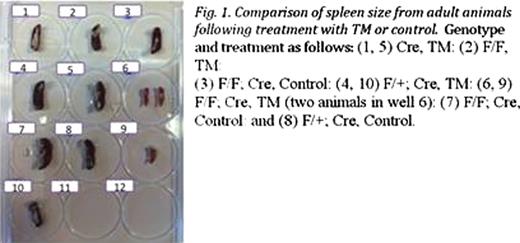Abstract
Abstract 2596
Laminins are heterotrimeric proteins composed of an alpha, beta, and gamma subunit, and are expressed in a majority of organ systems, including hematopoietic and lymphoid tissues. Specific laminin subunits have been identified in prognostic stromal gene expression profiles from diffuse large B-cell lymphomas (Lenz et al. 2008). Laminin g1 is the gamma-subunit present in a majority of physiologically expressed laminin heterotrimers. Global laminin-g1 deficiency in mice is embryologically lethal at E5.5 and results in part from failure of the primordial basal lamina to form (Smyth et al. 1998). Conditional knockout mouse lines have therefore been developed to examine the role of laminin-g1 in specific tissues. Disruption of Schwann cell-specific expression of laminin-g1 prevents basal lamina formation within peripheral nerves, decreases glial cell proliferation, and increases glial cell apoptosis leading to a severe dysmyelinated phenotype (Chen and Strickland 2003; Yu et al. 2005).
Here we present data that global disruption of laminin- g1 expression in adult animals induces involution of the spleen and suggests a fundamental role for laminins in maintenance of spleen integrity. Mice homozygous for the LoxP flanked laminin-g1 allele (floxed allele) were crossed with mice expressing a global Cre-ERT2 transgene. Mice homozygous or heterozygous for the floxed laminin-g1 allele that carry the inducible Cre transgene are hereafter referred to as homozygous and heterozygous mutant mice, respectively. Adult heterozygous and homozygous mutant animals were treated with either tamoxifen (TM) or corn oil (control), and three weeks afterwards, tissues were harvested for analysis. Treatment of homozygous mutant mice with TM, but not corn oil, induced laminin-g1 gene recombination. There was a significant decrease in spleen size in TM-treated but not control-treated homozygous mutant animals. Neither TM nor control treatment induced changes in the spleen size of heterozygous mutant animals. Similarly, TM treatment did not alter spleen size of animals that expressed Cre-transgene but were wild type with respect to the floxed laminin-g1 gene, or which were homozygous for the floxed laminin-g1 gene but lacked the Cre-transgene (Figure 1).
Comparison of spleen size from adult animals following treatment with TM or control. Genotype and treatment as follows (1, 5) Cre, TM: (2) F/F, TM:(3) F/F, Cre, Control: (4, 10) F/+;Cre, TM:(6, 9) F/F, Cre, TM (two animals in well 6): (7) F/F; Cre, Control and (8) F/+; Cre, Control.
Comparison of spleen size from adult animals following treatment with TM or control. Genotype and treatment as follows (1, 5) Cre, TM: (2) F/F, TM:(3) F/F, Cre, Control: (4, 10) F/+;Cre, TM:(6, 9) F/F, Cre, TM (two animals in well 6): (7) F/F; Cre, Control and (8) F/+; Cre, Control.
This is the first animal model to show that continued expression of laminins are critical for maintenance of the normal spleen and suggests a potential new target for disorders of lymphoid or splenic hyperproliferation.
Chen ZL, Strickland S. 2003. Laminin gamma1 is critical for Schwann cell differentiation, axon myelination, and regeneration in the peripheral nerve. J Cell Biol 163(4):889-99.
Lenz G, Wright G, Dave SS, Xiao W, Powell J, Zhao H, Xu W, Tan B, Goldschmidt N, Iqbal J and others. 2008. Stromal gene signatures in large-B-cell lymphomas. N Engl J Med 359(22):2313–23.
Smyth N, Vatansever HS, Meyer M, Frie C, Paulsson M, Edgar D. 1998. The targeted deletion of the LAMC1 gene. Ann N Y Acad Sci 857:283–6.
Yu WM, Feltri ML, Wrabetz L, Strickland S, Chen ZL. 2005. Schwann cell-specific ablation of laminin gamma1 causes apoptosis and prevents proliferation. J Neurosci 25(18):4463–72.
No relevant conflicts of interest to declare
Author notes
Asterisk with author names denotes non-ASH members.


This feature is available to Subscribers Only
Sign In or Create an Account Close Modal